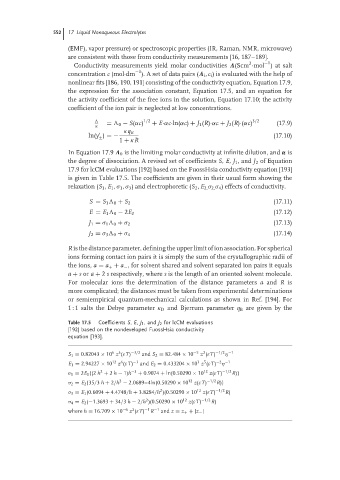Page 578 - Handbook of Battery Materials
P. 578
552 17 Liquid Nonaqueous Electrolytes
(EMF), vapor pressure) or spectroscopic properties (IR, Raman, NMR, microwave)
are consistent with those from conductivity measurements [16, 187–189].
2
−1
Conductivity measurements yield molar conductivities Λ(Scm ·mol )atsalt
−3
concentration c (mol·dm ). A set of data pairs (Λ i , c i ) is evaluated with the help of
nonlinear fits [186, 190, 191] consisting of the conductivity equation, Equation 17.9,
the expression for the association constant, Equation 17.5, and an equation for
the activity coefficient of the free ions in the solution, Equation 17.10; the activity
coefficient of the ion pair is neglected at low concentrations.
= 0 − S(αc) 1/2 + E·αc·ln(αc) + J 1 (R)·αc + J 2 (R)·(αc) 3/2 (17.9)
α
κq B
ln(y ) =− (17.10)
±
1 + κR
In Equation 17.9 Λ 0 is the limiting molar conductivity at infinite dilution, and α is
the degree of dissociation. A revised set of coefficients S, E, J 1 , and J 2 of Equation
17.9 for lcCM evaluations [192] based on the FuossHsia conductivity equation [193]
is given in Table 17.5. The coefficients are given in their usual form showing the
relaxation (S 1 , E 1 , σ 1 , σ 3 ) and electrophoretic (S 2 , E 2, σ 2, σ 4 ) effects of conductivity.
S = S 1 0 + S 2 (17.11)
(17.12)
E = E 1 0 − 2E 2
(17.13)
J 1 = σ 1 0 + σ 2
(17.14)
J 2 = σ 3 0 + σ 4
R is the distance parameter, defining the upper limit of ion association. For spherical
ions forming contact ion pairs it is simply the sum of the crystallographic radii of
the ions, a = a + + a − , for solvent shared and solvent separated ion pairs it equals
a + s or a + 2 s respectively, where s is the length of an oriented solvent molecule.
For molecular ions the determination of the distance parameters a and R is
more complicated; the distances must be taken from experimental determinations
or semiempirical quantum-mechanical calculations as shown in Ref. [194]. For
1 : 1 salts the Debye parameter κ D and Bjerrum parameter q B are given by the
Table 17.5 Coefficients S, E, J 1 ,and J 2 for lcCM evaluations
[192] based on the nondeveloped FuossHsia conductivity
equation [193].
2
3
6
S 1 = 0.82043 × 10 z (εT) −3/2 and S 2 = 82.484 × 10 −5 z (εT) −1/2 −1
η
3
−2 −1
5
6
E 1 = 2.94227 × 10 12 z (εT) −3 and E 2 = 0.433204 × 10 z (εT) η
2
σ 1 = 2E 1 {(2 h + 2 h − 1)h −3 + 0.9074 + ln(0.50290 × 10 12 z(εT) −1/2 R)}
2
σ 2 = E 2 {35/3 h + 2/h − 2.0689–4ln(0.50290 × 10 12 z(εT) −1/2 R)}
2
σ 3 = E 1 (0.6094 + 4.4748/h + 3.8284/h )(0.50290 × 10 12 z(εT) −1/2 R)
2
σ 4 = E 2 (−1.3693 + 34/3 h − 2/h )(0.50290 × 10 12 z(εT) −1/2 R)
2
−1 −1
where h = 16.709 × 10 −6 z (εT) R and z = z + +|z − |

